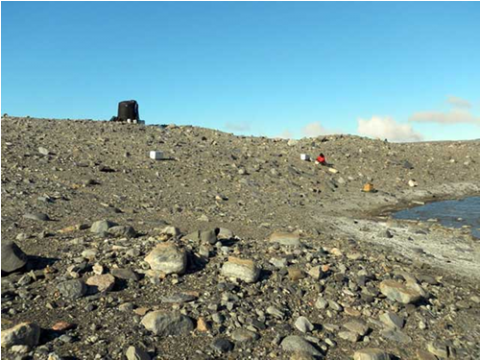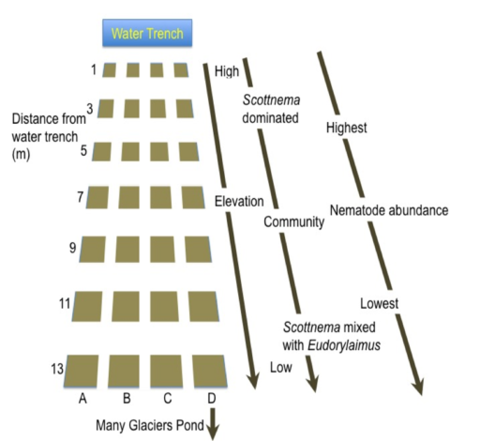

In 2011 we initiated a long-term study to test hypotheses about how the MCM soil ecosystem will respond to climate-mediated changes to permafrost. Our objective was to simulate different frequencies of permafrost thawing events and characterize their associated impacts on soil communities and biogeochemical cycles. Because the top horizons of most MCM soils are dry permafrost (insufficient water content to generate ice-cement) with an ice table (ice-cement or massive buried ice) below 30cm, we predicted that permafrost thaw events would produce subsurface mobilization of water, biota and nutrients at the soil active layer. Therefore, to simulate permafrost thaw we constructed water injection sites across the top of a hillslope where we could introduce liquid water at the surface of the permafrost active layer and measure its effect on the soil environment as it moves (beneath the surface of the soil) downslope (Fig. 2). During the first weeks of January over the past six years we have applied 1500 liters of sterilized water to two 8 x 20 m plots adjacent to an un-manipulated reference plot. One plot gets water every year, and one plot gets water additions every other year to simulate a “press, and “pulse” type “disturbance”, respectively.
We have found that simulated permafrost thaw increases soil water content but contrary to our predictions increased the heterogeneity in major ion content. Mixed linear effects models revealed significant, but subtle effects of simulated permafrost thaw on nematode populations. For example, there was a 2-way interaction between treatment*position in 2019 S. lindsayae populations (p<0.01), which is manifest as a decrease in S. lindsayae in soils with higher water content and most apparent in “press” plots. In contrast, Eudorylaimus spp. increased with higher water content in all plots, and decreased with increasing electrical conductivity. Changes in water content associated with interannual variation in snowpack and relative humidity exceed the treatment effects observed, especially in high snowpack years of 2014, 2017, and 2018. Moreover, treatments enhanced inter-annual variation in water content and solutes. These observed changes in soil water and solute chemistry influenced soil nematode and bacterial communities. Decreases in the dominant nematode Scottnema lindsayae were evident in the wettest patches of the press plots. In contrast, increases in the subordinate nematode Eudorylaimus spp. were observed in patches where soil water content had increased, as either a treatment effect or due to increased snowpack. The bacterial communities however, differed across the plots by distance from the trench and by year (p<0.001). Thus, while the effects of increased moisture are significant only at the patch scale for the nematode communities, significant differences among the bacterial communities are observed across the plots and between years. These results suggest domain-level differential responses to increased moisture and the resistance of soil nematode communities to water presses and pulses following a permafrost thaw simulation over the time scale of five years.
